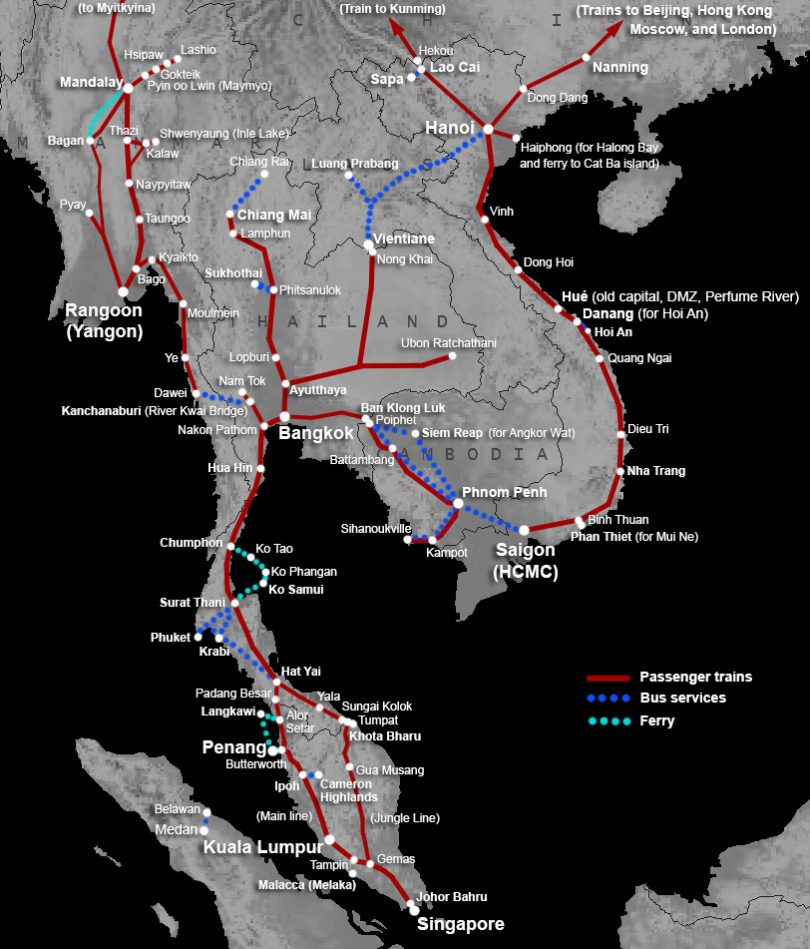Connecting Thailand with China and Singapore by rail, expanding a domestic network in the system also connecting tourism destination and easing air pollution is a gigantic project in progress at this time.
The Thai government has committed to spending more than US$21 billion to expand Bangkok’s rail transit, extend train lines, and build high-speed rails – with a massive US$1.3 billion hub at the center that will become South-east Asia’s largest train station when it opens in 2021.
Thailand’s rail ambition serves as a tool not only to reduce fossil fuel use but also to boost the struggling economy, overhaul its dated train system and tame its currency.
The plan is part of the government’s move to ease air pollution.
Thailand’s rail ambition serves as a tool not only to reduce fossil fuel use but also to boost the struggling economy, overhaul its dated train system and tame its currency. The rail network is a flagship infrastructure project that’s viewed as a major support for an economy reeling from a severe drought and a slump in tourism as a result of the coronavirus outbreak.
The majority of the US$33 billion infrastructure budget over the next three years will be spent on rail projects, with the goal that it will bring more private investment and boost consumption as Thailand seeks to recover from the slowest growth in five years.
The development will double the state passenger rail’s capacity and triple the freight capacity through track doubling. It’s expected to serve more than 22 million commercial passengers annually after the upgrade, and transport more than 30 million tons of commodities. High-speed rail will connect key Thai cities to Bangkok, a city of 10 million residents and 20 million visitors where the transit system will also double in a number of lines.
Even though Chinese and Japanese rail systems dwarf that of Thailand, such expansion is rare for the country, where the network had been undeveloped for almost seven decades as it turned to highways. The state rail network reached 3,300km in 1951, but has added only about 700km over the past 69 years.
For Mr Voravuth, who has been at the rail agency for three decades, he’s now starting to see the projects that were discussed during his early years come to fruition. By 2037, the network length is expected grow by 60 per cent with routes added to tourist destinations and border towns.
The double-track rails will make transportation of goods and passengers more efficient and reduce the logistic costs in the country, said Manoj Lohatepanont, director of Chulalongkorn University Transportation Institute. However, high-speed rails will not see enough demand for at least a decade, and the government still needs to develop suitable feeder systems for Bangkok transit to increase usage, he said.
Thailand’s first high-speed rail will connect to the Chinese rail at the Lao capital of Vientiane. It will be built by China, and will become part of the Belt and Road Initiative. It will also serve a purpose of taming the baht, which has strengthened last year partly because of a healthy current account and large foreign-cash pile.
The contract with the Chinese counterpart will be expressed in US dollars, said Mr Kobsak Pootrakool, secretary of the Economic Ministers Council.
The first phase of the 608km rail is under construction. The second phase, which would connect to the Chinese railway in Laos, is in the design process. Several high-speed contracts covering 668km and 970km routes are being planned.
When the giant Bangkok station opens in early 2021, the rail agency plans to slowly phase out the old diesel locomotives and replace them with electric trains, according to State Railway’s Voravuth. The idea is in line with the country’s power plan to reduce shares of electricity produced from fossil fuels and increase more shares form renewable sources.
A few local companies have been investing in electric cars and ferries to reduce pollution and fossil fuel use, and some have been testing autonomous vehicles to connect homes to nearby transit stations.























